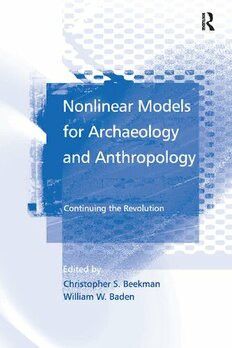
Nonlinear Models for Archaeology and Anthropology: Continuing the Revolution PDF
Preview Nonlinear Models for Archaeology and Anthropology: Continuing the Revolution
NONLINEAR MODELS FOR ARCHAEOLOGY AND ANTHROPOLOGY In memory o/Ilya Prigogine 1917-2003 Nonlinear Models for Archaeology and Anthropology Continuing the Revolution Edited by s. CHRISTOPHER BEEKMAN University 0/ Colorado at Denver and Health Sciences Center, USA WILLIAM W. BADEN Indiana University - Purdue University Fort Wayne, USA First published 2005 by Ashgate Publishing Published 2016 by Routledge 2 Park Square, Milton Park, Abingdon, Oxon OX14 4RN 711 ThirdAvenue, NewYork, NY 10017, USA Routledge is an imprint oft he Taylor & Francis Group, an informa business Copyright © 2005 Christopher S. Beekman and William W. Baden Christopher S. Beekman and William W. Baden have asserted their right under the Copyright, Designs and Patents Act, 1988, to be identified as the editors ofthis work. All rights reserved. No part ofthis book may be reprinted or reprodueed or utilised in any form or by any eleetronie, meehaniea1, or other means, now known or hereafter invented, inc1uding photoeopying and reeording, or in any information storage or retrieval system, without permission in writing from the publishers. Notiee: Produet or eorporate names may be trademarks or registered trademarks, and are used only for identifieation and explanation without intent to infringe. British Library Cataloguing in Publication Data Nonlinear models for archaeology and anthropology : eontinuing the revolution 1. Social arehaeology 2. Nonlinear systems I. Beekman, Christopher Stockard ll. Baden, William W. 930.1'01 Library of Congress Cataloging-in-Publication Data Nonlinear models for archaeology and antlrropology : continuing the revolution / edited by Christopher S. Beekman and William W. Baden. p.em. Inc1udes bibliographieal referenees and index. ISBN 0-7546-4319-0 I. Arehaeology--Mathematica1 models. 2. Nonlinear systems. I. Beekman, Christopher Stoekard. ll. Baden, William W. CC80.6.N66 2005 930.101 '51--dc22 2005024902 ISBN 9780754643197 (hbk) Contents List 01F igures vii List olTables ix List 01 Contributors xi Prelace xv Acknowledgements xvii 1 Continuing the Revolution 1 Christopher S. Beekman and William W. Baden 2 As Water for Fish: Human Groups as Complex Ecaptive Systems 13 Robert J. Hommon 3 Remember How to Organize: Heterarchy Across Disciplines 35 Carole L. Crumley 4 Agency, Collectivities, and Emergence: Social Theory and Agent Based Simulations 51 Christopher S. Beekman 5 Factional Formation and Community Dynamies in Middle-Range Societies 79 TammyStone 6 Modelling Prehistoric Maize Agriculture as a Dissipative Process 95 William W. Baden 7 Approaches to Modelling Archaeological Site Territories in the Near East 123 T.J. Wilkinson 8 Afterword 139 J. Stephen Lansing and Robert L. AxteIl Bibliography 147 Index 177 This page intentionally left blank List ofFigures 3.1 A heterarchy of nervous nets 39 3.2 Basic forms underlying the organization of all societies 49 4.1 Map ofthe Tequila valleys of central Jalisco, Mexico 71 4.2 Example shaft and chamber tomb used for elite interments throughout western Mexico 72 4.3 Circle 5, Navajas, Jalisco, Mexico 74 4.4 Mapped portion ofthe ceremonial centre ofNavajas 77 5.1 Location ofHopi villages 86 6.1 Cumulative maize yields on treated and untreated plots at Morrow Plots and Sanborn Field 112 6.2 Cumulative maize yields on treated and untreated plots at Cullar's Rotation and Wooster's Experimental Station 113 6.3 Estimated attainable yields for Morrow Plots and Sanborn Field 115 6.4 Estimated attainable yields for Cullar's Rotation and Wooster's Experimental Station 116 6.5 Average available land from an initial 20,000 ha base (n=100 simulations) 121 7.1 Sketch depicting the basic elements of site catchment analysis for a hypothetical coastal site showing different soil resource zones 1-3 126 7.2 Sketch depicting the basic elements of site sustaining areas (shaded circles) in direct proportion to the size ofthe contained archaeological sites (small black circles) 127 7.3 Sketch depicting the basic elements of site territory for the neighbourhood of a Bronze Age tell in Upper Mesopotamia. The inner zone (1) represents the dense field scatter, (2) the outer zone of cultivation, and (3) the pasture on the steppe beyond 129 7.4 Sketch of an enlarged landscape associated with a simple political economy. Arrows indicate the direction, but not the scale, of the enlarged catchment of the wealth or network economy. Shaded areas are cultivated land, neighbouring areas in white are the village pasture lands, areas beyond are the outlying pastures 131 7.5 Hollow way routes mapped for the central Khabur basin to the north and west ofTell Brak, from Ur 2004 134 7.6 Result of the withdrawal of labour from a model community as corvee or to fight a war. The spike shows the increased number ofexchanges ofanimals (sold) for grain (purchased). Simulation by J. Christiansen, courtesy of ANL Division ofInformation Sciences 136 This page intentionally left blank List of Tables 3.1 Characteristics ofcomplexity 36 3.2 Paradigm showing general range of fit between modelling strategies and different levels of ontological complexity in the social system 37 3.3 Characteristics of authority structures: Hierarchies and heterarchies 43 3.4 Ellickson's Five Controllers that provide substantive rules govem- ing behaviour 50 5.1 Timeline ofevents at Orayvi 88 6.1 Partial linear regression results on long-term, cumulative yields, Yield = bt + c 114 6.2 Nonlinear regression results for the ratio of cumulative yields, ft = a(tb) 114
